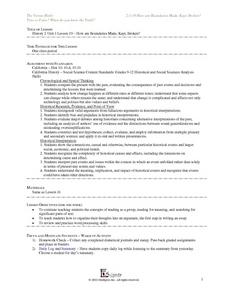Curated OER
The "Coal LIfecycle" Scrapbook
Students discover how coal is formed. In this science lesson plan, students create a scrapbook on the life cycle of coal and show how coal is formed by showing pictures of each stage.
Curated OER
How are Boundaries Created?
Students examine two new concepts: orientalism and objectification. They view two film clips/videos on Seven Years in Tibet with Brad Pitt to incorporate the new concepts. In addition, students read Orientalism and write key questions...
Curated OER
How Are Boundaries Made, Kept, Broken?
Students write a first draft of an essay reflecting their opinions of Things Fall Apart. They complete their circle diagrams, have them approved by the teacher, and write their essays. They write in their dialectical journals as they...
Curated OER
How Are Boundaries Made, Kept, Broken?
Students examine the different perspectives of Igbo women. They simulate a silent debate in response to the question, "Is the Igbo society sexist?" They write their response to the question and exchange papers with their partner as the...
Curated OER
How Are Boundaries Made, Kept, Broken?
Students complete essays reflecting themes in Things Fall Apart. They use Microsoft Word to revise, edit, and complete their essays. They complete their dialectical journals for Things Fall Apart.
Curated OER
How Was the Inside vs. Outside Paradigm Created?
Tenth graders write notes from a teacher lecture on Slavery and Exploitation. They review process for notetaking, symbols and abbreviations. They read three web articles about slavery and create a rubric for evaluating the quality of a...
Curated OER
Women's Roles: Then and Now
Fourth graders investigate women's roles during the frontier era in what is today's West Virginia. In this US history activity, 4th graders discuss similarities and differences of women's roles in the past with what women's roles are in...
Annenberg Foundation
Annenberg Learner: Journey North: Reading Strategies: Identify Author's Viewpoint
This reading resource discusses the strategy of identifying an author's viewpoint. A list of guiding questions is provided to help students as they analyze the author's viewpoint.
Sophia Learning
Sophia: Bias
Notes introducing bias and demonstrating how to identify slight, moderate, and strong bias in a text. Notes can be both read and listened to.
Sophia Learning
Sophia: Identifying Bias
This lesson explains how to identify an author's bias. This tutorial lesson shares a short slideshow with the lesson's content. An additional link is also provided to supplement this lesson on bias.
Better Lesson
Better Lesson: The True Story of Christopher Columbus
In this lesson, 5th graders analyze two nonfiction passages on Christopher Columbus to determine facts and author's bias and its influence on the readers.












